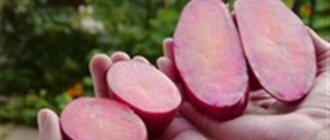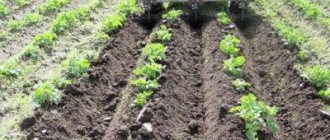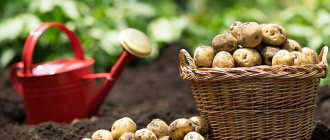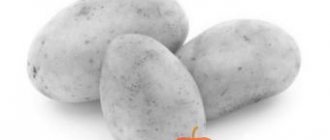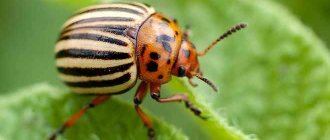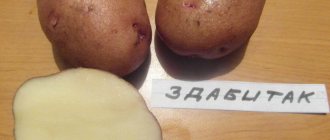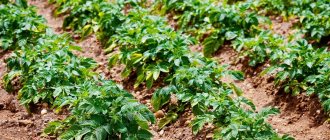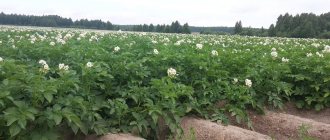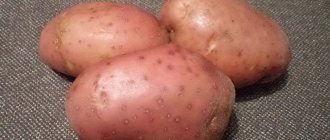Potatoes are a crop that is found in all summer cottages and garden plots. Gardeners grow it to obtain tubers used for food, large agricultural cooperatives - for sale to the population, for livestock feed, and less often - for the production of alcohol or starch.
In the technology of cultivating potatoes to obtain high yields, along with agrotechnical techniques and pest control, the correct choice of variety plays a huge role. This article will discuss the classification of potato varieties according to various characteristics, the suitability of growing them in certain regions into which Russia is divided; The 5 best varieties with fodder purposes are described.
Potato classification
All potato varieties are classified according to the following characteristics:
- Purpose (for food, for feed, technical purposes);
- Ripening time (in days from planting to harvest);
- The color of the peel and pulp that a potato tuber has.
Potato varieties
By purpose
Depending on the purpose, the following types of potatoes are distinguished:
- Table (edible) potatoes - varieties of this potato are used for preparing various dishes; they have good taste. These large potatoes have flattened tubers with a smooth or slightly rough surface and shallow-lying eyes, and have good keeping quality. The pulp of ware potatoes contains from 12 to 18% starch, many vitamins (C, B1, B2, B6, PP), proteins and other substances beneficial to the human body;
- Technical - potatoes with a high starch content (more than 16%) and an almost complete absence of protein compounds. Its varieties are used for the production of alcohol and starch;
- Feed – contains a lot of protein (more than 2%) and starch (more than 16-18%). Used as feed for pigs and cattle;
- Universal purpose - varieties of this potato combine all the advantages of the types described above and can be used both for food and for livestock feed, for technical purposes.
The most common table potatoes, depending on the degree of boilability and taste, are divided into 4 categories:
- A – almost uncooked. When cooked, the tubers of such potatoes remain intact and do not become overcooked. Used for preparing salads, okroshkas;
- B – slightly boiled. During the cooking process, the tubers are practically not softened. Good for boiling, frying;
- C – well boiled. The tubers are boiling. Used for making mashed potatoes, for frying;
- C – overcooked. Suitable for baking and making mashed potatoes. When frying, it loses its taste and disintegrates into a watery porridge.
According to the degree of cooking
According to early maturity
All potato varieties are divided into:
- Ultra-early - the period from the moment the seed was planted to harvest for varieties of this group is 40-55 days;
- Early – from 60 to 70 days;
- Mid-early - from 75 to 80 days;
- Mid-season - from 80 to 90 days;
- Medium late – 95-100 days;
- Late-ripening - have a late period (100-120 days or more) from planting to harvest.
By color of peel, pulp
The skin of potatoes can have the following color:
- White;
- Yellowish;
- Red;
- Purple.
Depending on the color of the tuber pulp, there are varieties of potatoes with:
- White pulp;
- Yellow pulp.
White pulp and yellow pulp
Less common are varieties with red and purple flesh.
Potato varieties for chips and deep frying
There are quite strict requirements for the varieties of French fries. Potatoes should be starchy, withstand shock well and not darken. In addition, it should be stored all winter without losing its taste. Only 2 varieties that are currently on the Russian market meet these conditions.
Anosta
The Dutch variety is resistant to most diseases, has yellow flesh, but, alas, the taste is only suitable for chips and fries - eating it in any other form will not be very pleasant. But its smooth tubers look beautiful and can attract the buyer’s eye.
Lady Claire
Another “chip” variety, the complete opposite of the previous one. It is soft, melts in your mouth, moderately starchy and slightly sweet. It can be stored for six months even without special conditions, but closer to spring it loses some of its taste.
Hope
Nadezhda's qualities are somewhere in the middle between Saturn and Lady Claire - it is quite starchy, tasty and stores well. Suitable not only for fries, but also for cooking. In addition, this variety is resistant to most diseases, and therefore requires almost no chemical treatments and will appeal to supporters of organic farming.
Saturn
Potatoes of this variety contain a lot of starch, they are hard like wood, do not have a strong taste and are perfectly stored. It is almost impossible to make puree from it, but it is ideal for fries.
Varieties according to early maturity for Russian regions
Dutch potato varieties
When choosing a variety based on early maturity, the region in which the crop will be grown is also taken into account:
- Southern regions - hot and drought-resistant early and ultra-early varieties, capable of producing up to several harvests per year (“Red Scarlett”, “Fioretta”, “Colette”);
- Middle zone - early and mid-early varieties. At the same time, in the eastern regions of the Middle Zone, preference is given to varieties with a longer ripening period, while in the central part, which includes, for example, the Moscow region, more early ripening varieties are preferred. The most popular varieties for this region are “Red Scarlett”, “Adretta”, “Udacha”, “Gala”, “Rosara”;
- Siberia – frost-resistant medium- and early-ripening varieties. Among them, the most popular are “Zhukovsky Early”, “Adretta”, “Alena”, “Udacha”;
- Far East - for the warm and humid climate of this region, such early and mid-early varieties as “Rosara”, “Fresco”, “Adretta”, “Sante”, “Asterix”, “Zhukovsky early” are suitable.
Advice. All new and already zoned potato varieties approved for cultivation in Russia are included in the “State Register of Breeding Achievements Approved for Use.” It contains not only lists of varieties, but also characteristics of their early ripening, regions of admission to cultivation, signs and year of zoning, names and contacts of originators and patent holders. Therefore, all information regarding a particular variety can be reliably obtained only in this publication. You can find and download its latest (current) version on the official resource of the Federal State Budgetary Institution “State Commission of the Russian Federation for the Testing and Protection of Selection Achievements”
Types of potatoes depending on the growing region
In the Urals and Siberia, sudden changes in temperature are common. Such conditions are destructive for many cultivated plants. For this reason, frost-resistant options are chosen:
- Governor and Lyubava are suitable for early harvest;
- Among the mid-season varieties, it is worth choosing Effect, Lukyanovsky, Korona, and Kaspiya varieties.
They grow well in the Leningrad region and the North-West region:
- Krinitsa;
- Dewdrop;
- Eliseevsky;
- Lena;
- Hope;
- Latona.
Most varieties of early, mid and late ripening potatoes are suitable for the soil in the Black Earth Region.
The climate of the Moscow region is characterized by high humidity, and the land here is considered not the most fertile. In such conditions the following are successfully grown:
- Timo Hankkiyan;
- Ramon.
Potatoes "Timo Hankkiyan"
Top 5 feed varieties
Early potato varieties for the Moscow region
When growing fodder potatoes, universal-purpose varieties are used. They, unlike technical and table varieties, are richer in protein and starch, have large tubers and good keeping quality.
The best varieties of potatoes for feed purposes are as follows:
- "Lorch";
- "Jeanne";
- "Arosa";
- "Rosara";
- "Sante."
Lorch
- Description – plants of this variety have tall, well-branched bushes of erect stems covered with large light green leaves. The inflorescence has a soft purple color. Up to 11 tubers can form under one bush, each having an average weight of up to 120 g. The starch content in tubers is high (up to 18-20%). The tubers are oblong in shape with thin yellow skin and white pulp. The keeping quality of tubers is 90-92%;
- Requirements for growing conditions - cultivated on medium- and highly fertile soils with a high content of potassium and phosphorus. Does not tolerate high temperatures and soil moisture deficiency;
- Ripening period – late-ripening variety, ripening 110-120 days after planting;
- Cultivation areas - North-Western, Central, Volga-Vyatka, Central Black Earth, North Caucasus, Middle Volga, Lower Volga, Ural and West Siberian;
- Productivity – from 200 to 300-350 c/ha;
- Resistance to pests and diseases - this is the oldest variety of domestic selection today (zoned and grown since 1931), susceptible to cancer, nematodes, and scab. It has moderate resistance to late blight.
Lorch
Colette
- Description – bushes of small height, medium spreading, consisting of stems covered with small leaves of rich green color with wavy edges. The inflorescences have a rich lilac color. The tubers are oval, oblong, have a smooth skin, with superficial, almost imperceptible eyes. The flesh and skin have the same yellowish or creamy yellow color. Under one bush, up to 11 tubers can form, weighing 100-125 g each with a starch content of up to 15-16%. The average shelf life of tubers is 92%;
- Requirements for growing conditions - grown in light, well-moistened soils with high and medium nutrient content. Does not like heavy and floating soils;
- Ripening period - this is an early ripening variety with a ripening period of 55-65 days;
- Cultivation areas - the variety has been zoned and is successfully cultivated in the North Caucasus, Central, Volga-Vyatka regions;
- Productivity – up to 500-600 c/ha;
- Resistance to pests and diseases - moderately resistant to scab and late blight. Resistant to cancer and golden nematode.
Colette
Arosa
- Description – this high-yielding variety is characterized by a dense bush with semi-erect stems and abundant rich green foliage. Inflorescences have a reddish tint. The tubers are large, elongated oval in shape with a reddish skin and yellow flesh, have a smooth surface with slight roughness and shallow-lying eyes. Under one bush, up to 12-15 tubers can form, weighing up to 120-140 g each. The starch content in the pulp ranges from 12 to 14-16%. The keeping quality of tubers is 95-96%;
- Requirements for growing conditions - grown on soils of different mechanical composition and fertility. Drought resistant;
- Ripening period - this early ripening variety ensures the ripening of tubers within 60-65 days after planting;
- Cultivation areas - the variety has been zoned and is successfully cultivated in the North Caucasus, in the Middle Volga and West Siberian regions;
- Productivity - this productive variety allows you to collect up to 450-500 centners of selected tubers per hectare;
- Resistance to pests and diseases - moderately resistant to scab and late blight. Resistant to cancer and golden nematode.
Arosa
Rosara
- Description – plants of this variety have compact, not spreading bushes of small height, consisting of stems covered with small oval-shaped leaves of a rich green color. Inflorescences are purple. The tubers are red, regular oval in shape with yellow flesh. Their surface has a pronounced roughness and shallow-lying eyes. Up to 20 tubers weighing up to 155 g each can form under one bush. The starch content in the pulp ranges from 12 to 16%. Keeping quality of tubers – 95-97%;
- Requirements for growing conditions – the variety is not demanding for growing conditions. Grown on any type of soil;
- Ripening period - an early ripening variety, allowing you to get a harvest within 60-65 days after planting;
- Cultivation areas - grown in all regions of Russia;
- Productivity – 300-400 c/ha;
Resistance to pests and diseases - moderately resistant to scab and late blight. Resistant to cancer and golden nematode.
Rosara
Sante
- Description – variety of Dutch selection. It has moderately spreading bushes of small height. The leaves are slightly dissected, small, richly dark green in color. Inflorescences are white. The tubers have a beautiful appearance: thin yellow skin, neat oval shape. Up to 20 tubers weighing 120-130 g each can form under one bush. The average starch content in tubers is 12-14%. With proper storage, up to 92% of the resulting tubers are preserved;
- Requirements for growing conditions - to grow the variety, highly fertile cohesive sandy or loamy soil with a high content of humus and nutrients is required;
- Ripening period - these mid-season potatoes have a tuber ripening period of 80-90 days;
- Cultivation areas - central and southern regions of Russia;
- Productivity – up to 400-600 c/ha;
Resistance to pests and diseases - slightly damaged by scab and late blight. Resistant to cancer and golden nematode.
Sante
Multicolored species
Colored potatoes are a new direction in the field of breeding. The creation of varieties with characteristic bright colors has gained incredible popularity and attracted the attention of many researchers and exotic chefs. Now this industry continues to develop and gain new momentum, and descriptions of potatoes of this kind can increasingly be found in magazines and blogs.
The properties of potatoes of unusual colors do not actually differ from ordinary varieties of this vegetable. However, colored potatoes are somewhat richer in vitamins, antioxidants and have an increased level of insulin, which helps improve a person’s well-being and replenish vitality.
Also, colored potatoes have their own nature. Thus, nature was able to independently create new varieties of potatoes that are not inferior in their exoticism to many fruits. This factor is highly valued among breeders. These new varieties have recently begun to appear in the public domain and become widespread in wide circles.
The beneficial properties of multi-colored potatoes depend on the richness of their color. The brighter the color of a vegetable, the more beneficial and nutritious it will be for the human body.
Blue potatoes or Vitelotte Noire are a variety of French origin. It is distinguished by its bright blue flesh and almost black skin. The weight of one potato is small and reaches only 70 grams, however, it is incredibly nutritious. The vegetable has a fairly high density, so it has good shelf life.
Black potatoes or Faerber - the variety is attractive for its appearance. It has a completely black skin and dark purple flesh. The taste is no different from ordinary potatoes, however, it contains quite a lot of starch, since when cooked it becomes crumbly. This species, which has joined new potato varieties, loves fertile soils rich in nutrients and moisture.
Purple potatoes - this variety has a pronounced purple color. It is rich in vitamins and retains its rich color even during heat treatment. Thanks to the thick peel, the vegetable is well stored, while retaining all its nutritional and beneficial properties.
Red potatoes or All Red are an incredibly tasty variety that was developed in America. It is distinguished by a red peel and soft pink flesh inside. The tubers are quite small and weigh only 50 grams. Red potatoes have become popular due to their delicate taste. This and many other varieties are actively cultivated in the agricultural town of Samokhvalovichi. It is in this small Belarusian town that breeders grow elite potato seeds, which are distinguished by their yield and excellent taste characteristics.
Other high-yielding varieties
Which potato varieties are better: red or white?
Among others not included in the top potato varieties described above, the following deserve attention:
- "Gala";
- "Timo";
- "Impala";
- "Zhukovsky early";
- "Luck";
- "Adretta."
It is necessary to purchase varietal potatoes for planting only in specialized stores and seed farms. If you buy planting material secondhand on the market, then no one guarantees the buyer that the purchased seeds belong to one particular variety (only a specialist, a breeder can distinguish one variety from another by external signs), their germination capacity and not being infected with various infections. The purchased planting material must be large enough - the weight of individual potatoes must be at least 50-60 g. Contrary to popular opinion, small tubers, which are called “achene”, will not develop plants that are strong enough and resistant to diseases and pests. In the future, this will not allow realizing the full potential of the variety and obtaining good yields.
Where to buy seed potatoes?
buy seed potatoes :
- In specialized stores. This primarily applies to small wholesale purchases. Here, seed potatoes are purchased for planting in subsidiary plots, dachas, vegetable gardens, and also in small farms.
- From companies specializing in the cultivation and sale of seed potatoes . Firms can engage in both domestic selection and direct supplies of seed potatoes from abroad.
The list of foreign suppliers of seed potatoes and their supply volumes can be found at the link – Suppliers of seed potatoes to Russia in 2013-2015. With a complete list of analytical reviews of the potato and vegetable growing industry - Potato and vegetable market reviews. We also offer for download a demo version of the study regarding seed potato suppliers in 2013-2015:
Planting recommendations for different geographic locations
Select varietal varieties of potatoes for different regions, taking into account climatic characteristics, harvest goals, as well as the ripening time of tubers. The root crop grows well and actively in a loose, nutrient-rich substrate. Fertilize, make high beds and regularly loosen the soil to get a rich harvest.
For different regions, the following varieties received positive feedback on high productivity:
- potato varieties for the Urals, northern regions (Karelia, Komi, Murmansk, Arkhangelsk region, etc.) - Romano, Impala, Aurora, Zhukovsky, Sante, Karatop, Rozhdestvensky, Latona, Freske, Alena;
- proven, as well as new potato varieties for the Middle Zone (Moscow, Kostroma, Tula, Smolensk regions, etc.) - Timo, Belorussky, Udacha, Vyatka, Druzhny, Sosnovsky, Slavyanka, Lugovskoy, Vesna, Nevsky, Zhukovsky;
The most productive varietal varieties of potatoes, with proper care, depending on the period of formation and ripening of the fruit, yield a harvest in 2-3 months. Select seeds that will have time to form tubers before the onset of cold weather.
The most beautiful potatoes: table with names and descriptions
The external attractiveness of root vegetables provides additional commercial, culinary and aesthetic advantages. The most beautiful potato varieties are presented in the table below.
| Variety | Ripening time, days | Country of origin | Description of tubers |
| Arosa | 50-75 | Germany | Round-elongated, deep pink with dark yellow flesh |
| Rocco | 90-150 | Holland/Austria | Red, with a creamy center. 8-12 pieces per bush weighing 100-120 g |
| Rosara | 65-75 | Germany | Large, oval, with reddish skin and yellowish core |
| Serpanok | 45-60 | Ukraine | Smooth to the touch, oval, pink. They have complex resistance to scab, cancer, viruses |
| Laura | 70-80 | Germany | Elongated, pink, honey-golden inside. Suitable for any dish |
| Courage | 75-90 | Holland | Smooth red with light yellow flesh, weighing up to 150 g |
| Reserve | 65-80 | Russia | Round, glossy, with white core and skin |
| Desiree | 80-95 | Holland | Red, oval, yellowish inside. |
To achieve optimal results and ideal fruit shape, it is necessary to monitor the density of the soil. Too heavy soil contributes to slow development and severe deformation of tubers.
Late potato varieties: table with descriptions and names
Long-term ripening ensures increased strength of the peel, which has a positive effect on keeping quality (shelf life), taste properties, and resistance to external damage. For convenience, brief descriptions of popular late potato varieties are summarized in a compact table.
| Variety | Ripening time, days | Description of tubers |
| Lasunok | 110-130 | Rounded-oval with creamy flesh, weighing up to 200 g (8-12 pieces). The skin is light yellow with a mesh texture. Productivity from one hundred square meters to 500 kg and above. They have good resistance to most viruses. |
| Picasso (Limonka) | 120-140 | Yellowish, with small pink eyes, weighing 100-130 g. The core is juicy, with a creamy tint. Not susceptible to drought, transport damage, nematodes and cancer. |
| Kiwi | 120-140 | Orange-brown, rough, with white flesh. Productivity 350-400 kg per hundred square meters. Not demanding on climate, soil composition, storage conditions (keeping quality up to 97-98%). They have enhanced immunity against scab and late blight. |
| Zhuravinka | 110-120 | Oval-round, red on the outside, honey-yellow on the inside, velvety to the touch. Moderately boiled, do not darken in boiling water. Up to 15-18 pieces per bush weighing 100-140 g. Optimal for light soils, including those lacking nitrogen. They are not afraid of scab, nematodes, and rhizoctonia. |
| Zdabytok | 120-130 | Oblong, with yellow peel, light lemon center. Average weight – 100-130 g. Resistant to viruses and diseases. Well kept. |
| Kuroda | 120-140 | Smooth, red, with soft straw-colored flesh. They are distinguished by high productivity (up to 600 kg per hundred square meters). Resistant to damage. Well transported. Do not turn black during heat treatment. |
Important!
After 3-4 years, even the most resistant variety loses its advantages and begins to degenerate. The way out of the situation is to re-purchase high-quality planting material.

